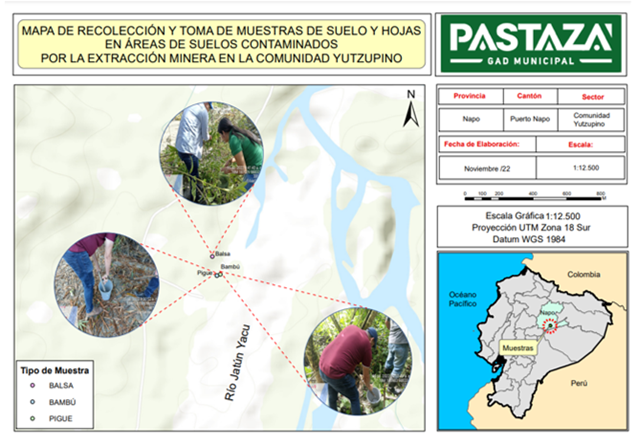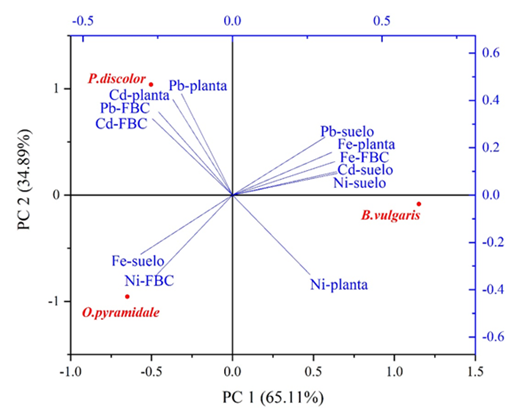Mi SciELO
Servicios Personalizados
Articulo
Indicadores
-
 Citado por SciELO
Citado por SciELO
Links relacionados
-
 Similares en
SciELO
Similares en
SciELO
Compartir
Revista Cubana de Ciencias Forestales
versión On-line ISSN 2310-3469
Rev CFORES vol.12 no.1 Pinar del Río ene.-abr. 2024 Epub 01-Abr-2024
Original article
Potential bioaccumulator of heavy metals for phytoremediation as an alternative for the recovery of the forest landscape in a mining extraction area, Napo, Ecuador
1Universidad Estatal Amazónica. Ciudad de Puyo, Provincia de Pastaza, Ecuador.
2Universidad Estatal Amazónica. Gobierno Municipal del Cantón Pastaza, Ciudad de Puyo, Provincia de Pastaza, Ecuador.
3Empresa Forestal de Pinar del Río. Pinar del Río, Cuba.
In the Ecuadorian Amazon, the challenges for identifying, phytoremediation species that reduce heavy metal contamination resulting from mining activity are increasing every day. The objective of this work was to evaluate the bioaccumulator potential of heavy metals of three fast-growing forest species (Ochroma pyramidale, Piptocoma discolor and Bambusa vulgaris) in a mining extraction area, in the Yutzupino community, Napo for restoration. Leaf and soil samples were collected to determine the concentration of heavy metals (Cd, Pb, Fe and Ni) using atomic absorption spectrometry and the bioconcentration factor (BCF) was calculated. Leaf analyzes showed that B. vulgaris presented a higher concentration of Ni (6.89 mg kg-1 ) and Fe (156.33 mg kg-1 ) and P. discolor contained Cd (0.35 mg kg-1 ) and Pb (55.67 mg kg -1 ). Soil analyzes showed a pattern of variation in B. vulgaris superior in Cd, Ni and Pb and in O. pyramidale for Fe. The bioconcentration factor allowed identifying the accumulating capacity of the species, which suggests that P. discolor may be used as a phytoremediation species for sites contaminated by Cd and Pb, O. pyramidale for Ni and B. vulgaris for Fe.
Key words: soil contamination; foliar analysis; fast-growing species; mining; Ecuadorian Amazon.
INTRODUCTION
Heavy metals are naturally present in the environment, in concentrations that generally do not harm different forms of life, while those that come from anthropogenic activities such as industrial, technological, agricultural, mining pollution and the misuse of soils by Various chemical fertilizers can raise concentration levels relative to normal parameters. These contaminants enter rivers, vegetables, animals and foods, thus altering the sustainability of the food chain, presenting potential risks to nature and society, as they cause serious human and animal health problems (Londoño Franco et al., 2016).
The forest ecosystems of the Ecuadorian Amazon are threatened by poor mining extraction practices, recognized as one of the main environmental problems that affect the deforestation of extensive forest areas, thus facilitating processes such as landslides, landslides, erosion and high levels of contamination in the soil from mineral extraction (Delgado et al., 2023).
Artisanal and small-scale gold mining is among the most important sources of heavy metals in ecosystems, causing serious pollution (Jacka, 2018). In the province of Napo, community of Yutzupino, there is a gradual modification of the forest landscape, due to open pit exploitation carried out for the extraction of metallic minerals (gold), presumably by illegal miners within the mining concession. The mining activities carried out in the area lead to the accumulation of washed gravel tailings and the generation of sediments, which, by not having any type of technical consideration, accelerate soil erosion, change in relief, formation of artificial wells (swamps), landslides and production of gravel mounds of different sizes. These activities have caused the contamination of heavy metals in the soil and in the leaf tissues of the different forest species that inhabit this important forest reservoir.
Despite heavy metal contamination, some plant species have developed strategies to thrive in conditions of high concentrations of heavy metals, making them species with potential for application in phytoremediation processes.n. Haga clic o pulse aquí para escribir texto.. Las plantas metalófitos son especies que han desarrollado mecanismos fisiológicos para resistir, tolerar y sobrevivir en suelos degradados por la minería. Estas plantas pueden limitar la absorción de metales o trasladarlos a las hojas o absorberlos activamente y acumularlos en su biomasa aérea, las cuales pueden ser utilizadas en procesos de fitorrehabilitación y fitorremediación para restaurar sedimentos y aguas contaminadas con metales pesados y eliminar contaminantes en el ambiente (Jara-Peña et al., 2014).
Hence, the objective of this work was to evaluate the bioaccumulator potential of heavy metals of three forest species (Ochroma pyramidale, Piptocoma discolor and Bambusa vulgaris) in a mining extraction area, in the Yutzupino community, Napo for phytoremediation purposes.
MATERIALS AND METHODS
Study area
The research was carried out in a mining extraction area, located in the Yutzupino community, eastern Ecuadorian region, belonging to the province of Napo, Tena canton, Puerto Napo parish. The geographical limits were found to the SE with the parish of Puerto Napo and SW with the Napo River. Figure 1 shows the location of the material collection points, which corresponds to an Amazonian evergreen forest.
Species selection and sample collection
O. pyramidale, P. discolor and B. vulgaris) were selected, taking as criteria that they were species of ecological and economic importance with predominance in the piemontane evergreen forest ecosystems, fast growing and widely distributed in the Amazon region., with high abundance in the study area and with the capacity to adapt to environmental conditions and changes, which facilitate understanding its response as a bioaccumulator of heavy metals.
Leaf samples were collected from adult individuals, exposed to the sun and in good physical condition. The plant material was collected from different sides of the trees, for which the branches were cut to avoid contact of the leaves with the metal of the scissors (Hu et al., 2003).
Soil samples were taken at three points, under the canopy of the selected individuals, at a depth of 0-30 cm, with the use of an auger (Greksa et al., 2019). The leaf litter and roots present were removed from the soil samples, they were labeled and transferred to the Environmental Studies Laboratory of the Amazon Experimental Research and Production Center (CEIPA).
Determination of heavy metals and bioconcentration factor
Heavy metals (Cd, Pb, Fe and Ni) were determined in the leaf and soil samples, respectively. The plant material samples were washed with drinking water and then with distilled water; They were allowed to dry naturally on filter paper for four days, then dried in a dryer at 40 °C for 48 h and pulverized without the use of sharp metals (approximately 20 g) (ISO, 1995). The digestion of the plant material was carried out with a mixture of nitric acid (HNO3) 65 % and 37 % hydrogen peroxide (H2 O2) in a 7:1 ratio (wet digestion) in an open container (Kalra, 1997)
A sample of 100 g of soil was taken, which was air dried, at room temperature, for four days on filter paper. They were subsequently crushed, passed through a 2 mm mesh sieve and dried in an oven at a temperature of 40 °C for 48 h. (Šichorová et al., 2004) The determination of the elements in the soil samples was carried out with 0.5 g of soil digestion, air-drying with 12 ml of aqua regia and with a 1:2 proportion of HNO3 HCl at boiling for 2 h, followed by filtration and volume adjustment in a 100 mL volumetric flask (ISO, 1995).
The quantification of heavy metals in leaves and soil was carried out in a Perkin-Elmer 2380 atomic absorption spectrophotometer. A standard of 1000 ppm of each metal was used for the equipment calibration curve and the corresponding lamp was placed.
Bioconcentration factor (BCF) was calculated as a proportion of the concentration of elements in plants and soil, which represents the capacity of the plant to absorb heavy metals from the growth media (Alahabadi et al., 2017). The BCF was calculated using Equation 1:
where C follajeand and Csuelo represent the concentration of a specific element in plant material (leaves) and soil, respectively.
To identify if a species can be used for phytoremediation purposes for sites contaminated by heavy metals, the value of each element was taken as a criterion based on the bioconcentration factor (BCF). To the extent that the value was higher, the use of the species as a good accumulator of the heavy metal in question is suggested (Aisien et al., 2010).
Statistical processing
An analysis of variance (ANOVA) and Tukey's test at 95% reliability were carried out to determine the significant differences between the study species in terms of the concentrations of heavy metals (Cd, Pb, Ni and Fe) at the leaf and tree levels. floor. The Pearson correlation matrix was obtained to determine the correlations between the concentrations of heavy metals analyzed in the plants, the soil and the bioconcentration factor. A principal component analysis (PCA) was used to establish the separation of the analyzed species depending on the concentrations of the heavy metals analyzed in the soil and in the plant. Origin 2021 software was used in all statistical analyses.
RESULTS AND DISCUSSION
The concentration of heavy metals at the leaf level (Figure 2) showed significant differences for Cd, Ni, Pb and Fe in the three study species (O. pyramidale, P. discolor and B. vulgaris). Regarding Cd, the species P. discolor presented higher values with averages of 0.35 mg kg-1, while B. vulgaris presented lower values (0.04 mg kg-). The foliar Ni concentration indicated that B. vulgaris had the highest values (6.89 mg kg-1) and P. discolor had the lowest values (4.90 mg kg-1). The Pb concentration resulted in higher means (55.67 mg kg -1) for P. discolor and lower means (9.65 mg kg -1 ) for B. vulgaris . Regarding Fe, the foliar concentration was higher in B. vulgaris (156.33 mg kg-1) and lower for O. pyramidale (32.85 mg kg-1).
These results are similar to those reported by Kabata (2010), where he obtained a concentration of Cd and Ni of 0.05-0.5 mg kg-1, indicating that it did not exceed the tolerance values, while Pb was between 30-300 mg kg-1, which exceeded the permissible toxicity values for plants. These results indicated that the concentration of Cd and Ni did not exceed the permissible values for any of the three species studied, while the concentration of Pb resulted in toxicity for the species P. discolor.
In the species B. vulgaris, it was found that the concentration of heavy metals at the leaf level was lower than that reported by Liu et al., (2015) and Liu et al., (2016) for Pb and Cd.
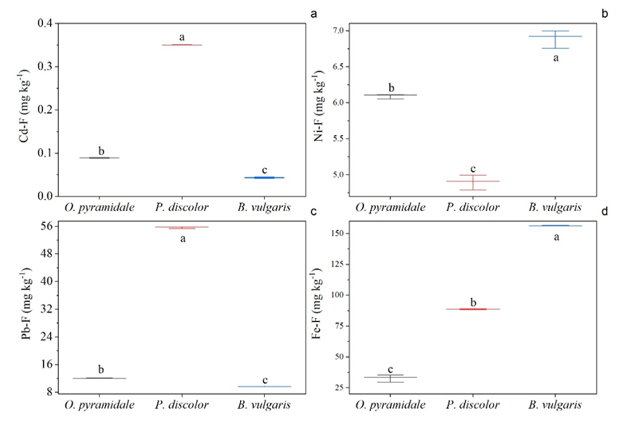
Fig. 2. - Results of the concentration of heavy metals in leaves of three species (O. pyramidale, P. discolor, B. vulgaris). (a) Cd-F (Leaf Cadmium), (b) Ni-F (Leaf Nickel), (c) Pb-F (Leaf Leaf) and (d) Fe-F (Leaf Iron). Inside the figure unequal letters indicated significant differences through analysis of variance (ANOVA) and Tukey test (p ≤ 0.05).
O. pyramidale, P. discolor and B. vulgaris developed showed significant differences (Figure 3). It was found that there is a pattern of variation at the species level similar to that reported for the foliar analysis. In relation to the behavior of Cd, Ni and Pb, the results indicated that the soil where B. vulgaris develops presented the highest values and O. pyramidale presented the lowest values, while for the concentration of Fe the values were higher in O. pyramidale and inferior for B. vulgaris. Regarding Cd at ground level, the concentration was found between 0.04 and 0.13 mg kg-1, in Ni it ranged from 7.27 to 18.24 mg kg-1 , in Pb it was from 22.7 to 57.67 mg kg-1 and in Fe it was from 536.21 to 845.28 mg kg-1 .
In accordance with Ecuadorian regulations (TULSMA, 2012) It was found that the concentration of Cd did not exceed the permissible values (0.5 mg kg-1 ), the Ni was found close to the critical values considered toxic (19.0 mg kg-1), the Pb exceeded the permissible values (19.0 mg kg-1) and Fe is not regulated. This indicated a high level of toxicity in the soil for the element Pb, which suggests actions for remediation with species that are capable of absorbing this heavy metal.
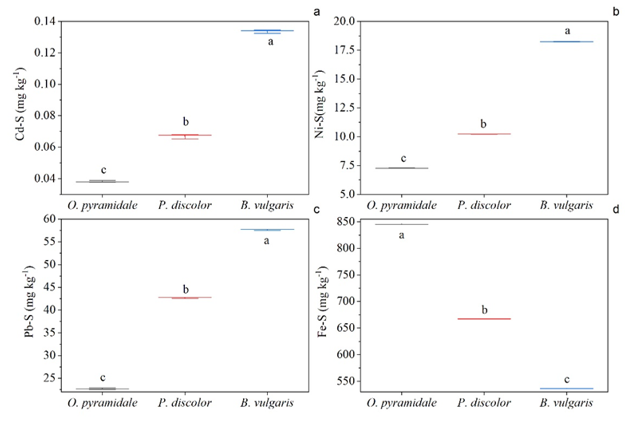
Fig. 3. - Results of the concentration of heavy metals in the soil where the species (- O. pyramidale, P. discolor, B. vulgaris) developed. (a) Cd-S (Cadmium soil), (b) Ni-S (Nickel soil), (c) Pb-S (Lead soil) and (d) Fe-S (Iron soil). Inside the figure unequal letters indicated significant differences through analysis of variance (ANOVA) and Tukey test (p ≤ 0.05).
The results of the bioconcentration factor (Figure 4) indicated that the P. discolor species was reported to have greater potential for Cd absorption with values of 5.23, resulting in significant differences with the rest of the species studied, which suggests its high bioaccumulator capacity in Cd. This same behavior resulted for the element Pb, with values greater than 1.3. These results are interesting because it is a pioneer species of the Asteraceae family that grows naturally in clearings, with a high degree of coverage in secondary forests. (González et al., 2018). This suggests its use as a phytoremediation species in sites where mining extraction practices and There is evidence of contamination by heavy metals of Cd and Pb.
However, the species O. pyramidale presented the highest Ni accumulation capacity with values greater than 0.8, indicating its potential for sites with high Ni content and B. vulgaris. It resulted in a greater Fe accumulation capacity with values greater than 0.29, which suggests its potential use for sites contaminated by Fe.
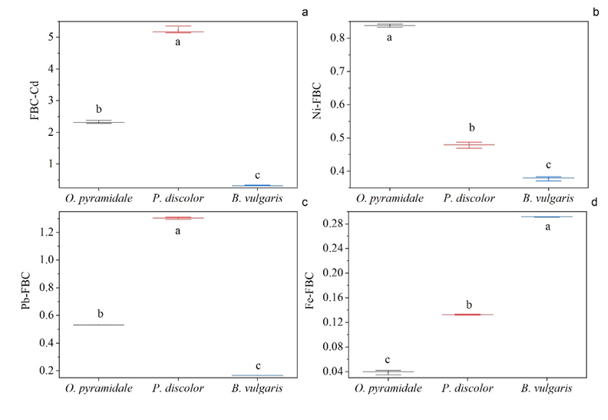
Fig. 4. - Results of the - heavy metal bioconcentration factor of the species (O. pyramidale, P. discolor and B. vulgaris). (a) Cdb-CBF (Cadmium bioconcentration factor), (b) Ni-CDF (Nickel bioconcentration factor), (c) Pb-Cd (Lead bioconcentration factor) and (d) Fe-Cd (Lead bioconcentration factor) of Iron bioconcentration). Inside the figure, unequal letters indicated significant differences by analysis of variance (ANOVA) and Tukey test (p ≤ 0.05).
The Pearson correlation matrix (Figure 5) for all the species analyzed showed a positive and negative correlation, less than 50 %, between the concentration of heavy metals between the leaves and the soil. These results indicated that the species in the present study, in a general sense, do not absorb everything that is available in the soil. In this sense, Song et al., (2007) report that the bioaccumulation capacity of plants does not depend entirely on the concentration of heavy metals in the soil, but is related to the physiology of the plant and its protective capacity. When plants are stressed by heavy metals, they have the ability to actively regulate the concentration of the elements (Fernández et al., 2017; Miao et al., 2011).
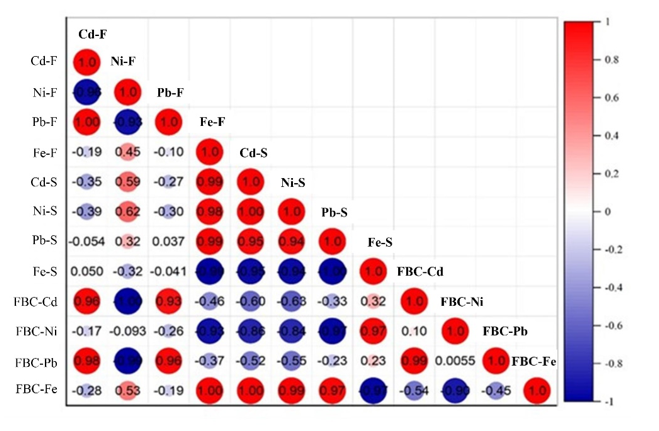
Fig. 5. - Correlation between the concentration of heavy metals in the leaves, the soil and the bioconcentration factor (the numerical value within the matrix corresponds to the Pearson correlation coefficient). The scale on the right means the values of the correlation coefficient, positive and negative, which ranges between +1 and -1 (the deep blue and red colors correspond to values close to +1 and -1 with high correlation and light colors with low correlation). The nomenclature on the left means the coded variables (Cd-F (Leaf Cadmium), Ni-F (Leaf Nickel), Pb- F (Leaf foliar), Fe-F (Leaf Iron), (Cd-S (Soil Cadmium), Ni -S (Nickel soil), Pb- S (Lead soil), Fe-S (Iron soil)
Principal component analysis (PCA), as an ordination method, indicated the reduction of two components that fully explained 100 % of the total variability of the data. The coordinate system, determined by the principal components, allowed us to identify that the species B. vulgaris was separated on the PC1 axis, which is located on the positive side of the axis. The species B. vulgaris showed a greater relationship with the concentration of Pb in the soil, Fe in the plant, Cd in the soil and Ni in the soil. The species P. discolor was found on the negative side of PC1, resulting in higher concentrations of Pb and Cd in the plant. The species O. pyramidale was found on the negative side of the PC2 axis, and was characterized by higher Fe concentrations in the soil. The analysis of the bioconcentration factor, in the coordinate system, resulted in a differentiated pattern between the forest species analyzed, reflecting for P. discolor greater retention of Cd and Pb, in O. pyramidale greater retention of Ni and in B. vulgaris of Fe. This suggests the bioaccumulator capacity of P. discolor for Cd and Pb, of O. pyramidale for Ni and of B. vulgaris for Fe, which could be used as phytoremediation species for sites contaminated by heavy metals (Figure 6).
CONCLUSIONS
Bioaccumulator potential of heavy metals (Cd, Ni, Fe and Pb) obtained from the bioconcentration factor (BCF) indicated the capacity of the forest species studied to accumulate heavy metals in sites contaminated by mining activity. This suggests that P. discolor can be used as a phytoremediation species for sites contaminated by Cd and Pb, O. pyramidale for Ni and B. vulgaris for Fe. These results may be useful to recommend similar studies with other native species, which is an feasible alternative for the recovery of the forest landscape.
REFERENCIAS BIBLIOGRÁFICAS
AISIEN, F., OLUWOLE, F., y AISIEN, E., 2010. Phytoremediation of Heavy Metals in Aqueous Solutions. Leonardo Journal of Sciences ENT#091;en líneaENT#093;, vol. 9, no. 17, Disponible en: https://citeseerx.ist.psu.edu/document?repid=rep1&type=pdf&doi=a00fc1cfaa8bfd3e474be2040dcf287f32b8b8cc. [ Links ]
ALAHABADI, A., EHRAMPOUSH, M.H., MIRI, M., EBRAHIMI AVAL, H., YOUSEFZADEH, S., GHAFFARI, H.R., AHMADI, E., TALEBI, P., ABASZADEH FATHABADI, Z., BABAI, F., NIKOONAHAD, A., SHARAFI, K., y HOSSEINI-BANDEGHARAEI, A., 2017. A comparative study on capability of different tree species in accumulating heavy metals from soil and ambient air. Chemosphere ENT#091;en líneaENT#093;, vol. 172, ENT#091;consulta: 08/04/2024ENT#093;. ISSN 0045-6535. DOI 10.1016/j.chemosphere.2017.01.045. Disponible en: Disponible en: https://www.sciencedirect.com/science/article/pii/S0045653517300553 . [ Links ]
DELGADO FERNÁNDEZ, E., LEÓN PERALTA, M., CANTOS GUAMÁN, C., y GUZMÁN JUÁREZ, M., 2023. Efecto de la actividad minera sobre la biodiversidad en un sector del cantón Paquisha, provincia de Zamora Chinchipe-Ecuador. LA GRANJA. Revista de Ciencias de la Vida ENT#091;en líneaENT#093;, vol. 38, no. 2, ENT#091;consulta: 08/04/2024ENT#093;. ISSN 1390-8596. DOI 10.17163/lgr.n38.2023.08. Disponible en: Disponible en: http://scielo.senescyt.gob.ec/scielo.php?script=sci_abstract&pid=S1390-85962023000200106&lng=es&nrm=iso&tlng=es . [ Links ]
FERNÁNDEZ-ONDOÑO, E., BACCHETTA, G., LALLENA, A.M., NAVARRO, F.B., ORTIZ, I., y JIMÉNEZ, M.N., 2017. Use of BCR sequential extraction procedures for soils and plant metal transfer predictions in contaminated mine tailings in Sardinia. Journal of Geochemical Exploration ENT#091;en líneaENT#093;, vol. 172, ENT#091;consulta: 08/04/2024ENT#093;. ISSN 0375-6742. DOI 10.1016/j.gexplo.2016.09.013. Disponible en: Disponible en: https://www.sciencedirect.com/science/article/pii/S0375674216302345 . [ Links ]
FRANCO, L.F.L., MUÑOZ, P.T.L., y GARCIA, F.G.M., 2016. Los riesgos de los metales pesados en la salud humana y animal. Biotecnología en el Sector Agropecuario y Agroindustrial ENT#091;en líneaENT#093;, vol. 14, no. 2, ENT#091;consulta: 08/04/2024ENT#093;. ISSN 1909-9959. DOI 10.18684/BSAA(14)145-153. Disponible en: Disponible en: https://revistas.unicauca.edu.co/index.php/biotecnologia/article/view/489 . [ Links ]
GREKSA, A., LJEVNAIÆ-MAŠIÆ, B., GRABIC, J., BENKA, P., RADONIC, V., BLAGOJEVIÆ, B., y SEKULIÆ, M., 2019. Potential of urban trees for mitigating heavy metal pollution in the city of Novi Sad, Serbia. Environmental Monitoring and Assessment ENT#091; en líneaENT#093;, vol. 191, no. 10, DOI 10.1007/s10661-019-7791-7. Disponible en: https://www.researchgate.net/publication/335841644_Potential_of_urban_trees_for_mitigating_heavy_metal_pollution_in_the_city_of_Novi_Sad_Serbia. [ Links ]
ISO, 11466, 1995. Soil quality - extraction of trace elements soluble in aqua regia. ENT#091;en líneaENT#093;. 1995. S.l.: ISO. Disponible en: https://www.iso.org/es/contents/data/standard/01/94/19418.html. [ Links ]
JACKA, J.K., 2018. The Anthropology of Mining: The Social and Environmental Impacts of Resource Extraction in the Mineral Age. Annual Review of Anthropology ENT#091;en líneaENT#093;, vol. 47, 2018, ENT#091;consulta: 08/04/2024ENT#093;. ISSN 0084-6570, 1545-4290. DOI 10.1146/annurev-anthro-102317-050156. Disponible en: Disponible en: https://www.annualreviews.org/content/journals/10.1146/annurev-anthro-102317-050156 . [ Links ]
JARA-PEÑA, E., GÓMEZ, J., MONTOYA, H., CHANCO, M., MARIANO, M., y CANO, N., 2014. Capacidad fitorremediadora de cinco especies altoandinas de suelos contaminados con metales pesados. Revista Peruana de Biología ENT#091;en líneaENT#093;, vol. 21, no. 2, ENT#091;consulta: 08/04/2024ENT#093;. ISSN 1727-9933. DOI 10.15381/rpb.v21i2.9817. Disponible en: Disponible en: https://revistasinvestigacion.unmsm.edu.pe/index.php/rpb/article/view/9817 . [ Links ]
KABATA-PENDIAS, A., 2010. Trace elements in soils and plants: Fourth edition ENT#091;en líneaENT#093;. CRC Press S.l.: s.n. ISBN 978-0-429-19203-6. Disponible en: https://www.researchgate.net/publication/328611305_Trace_elements_in_soils_and_plants_Fourth_edition. [ Links ]
KALRA, Y., 1997. Handbook of Reference Methods for Plant Analysis ENT#091;en líneaENT#093;. S.l.: CRC Press. ISBN 978-1-4200-4939-8. Disponible en: https://books.google.co.ve/books?id=wLggXPmhY18C&printsec=frontcover&hl=es#v=onepage&q&f=false. [ Links ]
LIU, X., TIAN, G., JIANG, D., ZHANG, C., y KONG, L., 2016. Cadmium (Cd) distribution and contamination in Chinese paddy soils on national scale. Environmental Science and Pollution Research ENT#091;en líneaENT#093;, vol. 23, no. 18, ENT#091;consulta: 08/04/2024ENT#093;. ISSN 1614-7499. DOI 10.1007/s11356-016-6968-7. Disponible en: Disponible en: https://doi.org/10.1007/s11356-016-6968-7 . [ Links ]
LIU, Y.-B., LIU, L., LI, Y.-F., y CHEN, Y.-L., 2015. Relationship between Health Literacy, Health-Related Behaviors and Health Status: A Survey of Elderly Chinese. International Journal of Environmental Research and Public Health ENT#091;en líneaENT#093;, vol. 12, no. 8, ENT#091;consulta: 08/04/2024ENT#093;. ISSN 1661-7827. DOI 10.3390/ijerph120809714. Disponible en: Disponible en: https://www.ncbi.nlm.nih.gov/pmc/articles/PMC4555308/ . [ Links ]
MIAO, L., MA, Y., XU, R., y YAN, W., 2011. Environmental biogeochemical characteristics of rare earth elements in soil and soil-grown plants of the Hetai goldfield, Guangdong Province, China. Environmental Earth Sciences ENT#091;en líneaENT#093;, vol. 63, no. 3, ENT#091;consulta: 08/04/2024ENT#093;. ISSN 1866-6299. DOI 10.1007/s12665-010-0718-9. Disponible en: Disponible en: https://doi.org/10.1007/s12665-010-0718-9 . [ Links ]
ŠICHOROVÁ, K., TLUSTOŠ, P., SZÁKOVÁ, J., KOØÍNEK, K., y BALÍK, J., 2004. Horizontal and vertical variability of heavy metals in the soil of a polluted area. Plant, Soil and Environment ENT#091;en líneaENT#093;, vol. 50, no. 12, ENT#091;consulta: 08/04/2024ENT#093;. ISSN 1214-1178, 18059368. DOI 10.17221/4069-PSE. Disponible en: Disponible en: https://doi.org/10.17221/4069-PSE . [ Links ]
SONG, C., LEI, L., y YANG, Q., 2007. Pb, Cu botanogeochemical anomalies and toxic effects on plant cells in Pb-Zn (Sn) ore fields, Northeast Guangxi Autonomous Region, China. Chinese Journal of Geochemistry ENT#091;en líneaENT#093;, vol. 26, no. 3, ENT#091;consulta: 08/04/2024ENT#093;. ISSN 1993-0364. DOI 10.1007/s11631-007-0329-7. Disponible en: Disponible en: https://doi.org/10.1007/s11631-007-0329-7 . [ Links ]
TULSMA, 2012. Texto Unificado de Legislación Secundaria de Medio Ambiente,. S.l.: TULSMA. Registro Oficial Edición Especial 2 de 31-Mar.-2003, 1319. https://www.ambiente.gob.ec/wp-content/uploads/downloads/2018/05/TULSMA.pdf [ Links ]
Received: February 06, 2024; Accepted: March 04, 2024











 texto en
texto en 

